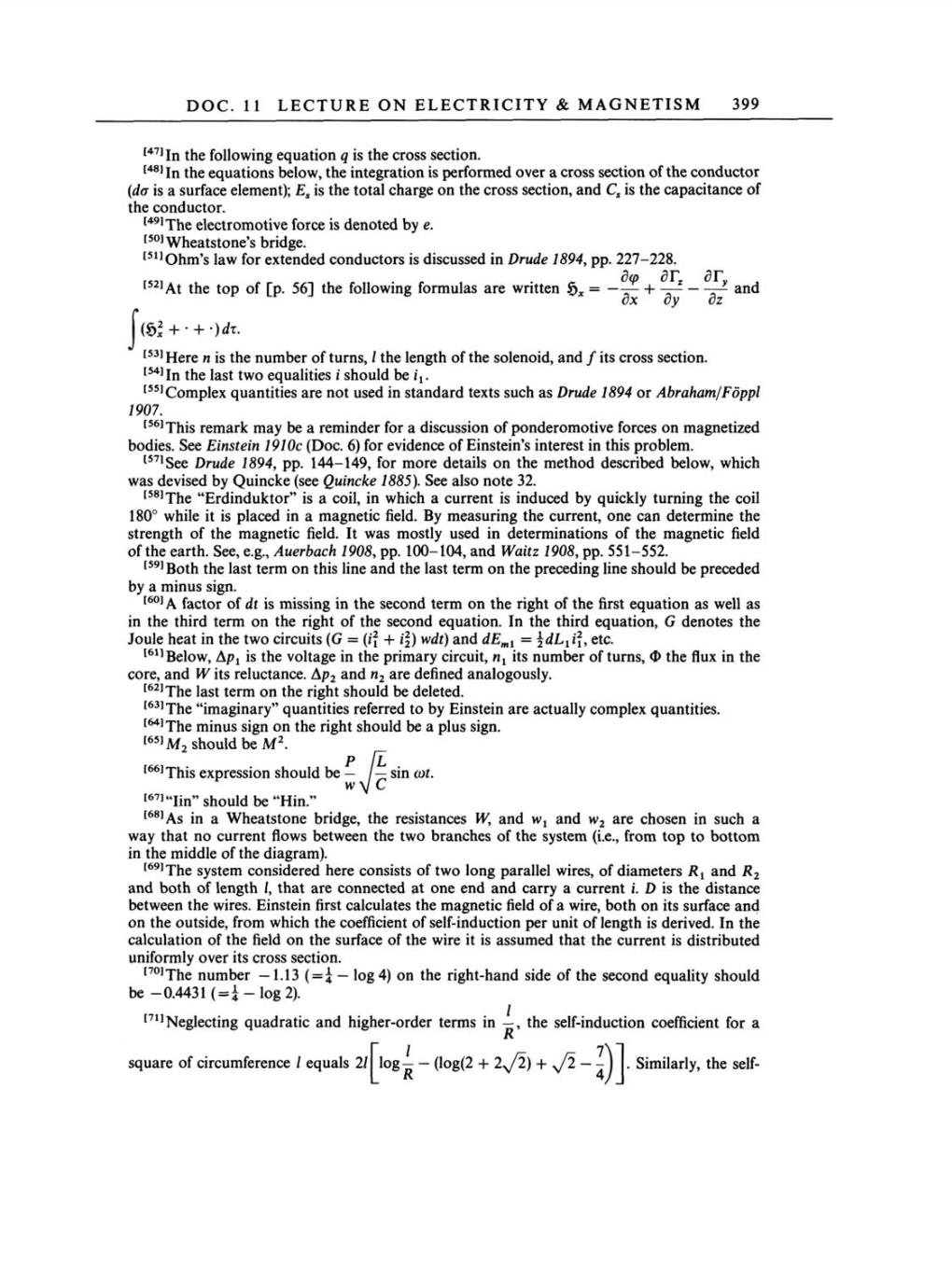DOC.
11
LECTURE ON ELECTRICITY
&
MAGNETISM
399
[47]In the
following equation
q
is
the
cross
section.
[48]In the
equations
below,
the
integration
is
performed
over a
cross
section of the conductor
(da
is
a
surface
element);
Es
is
the total
charge on
the
cross
section,
and
Cs
is
the
capacitance
of
the conductor.
[49]The
electromotive
force is
denoted
by e.
[50]Wheatstone's
bridge.
[51]Ohm's
law
for extended conductors
is
discussed
in Drude
1894, pp.
227-228.
d(p
d
dT
[52]At
the
top
of
[p. 56]
the
following
formulas
are
written
=
-
-
+
~~ -~~
and
ox oy cz
(&*
+
•
+
')di.
[53]Here
n
is
the number of
turns,
l
the
length
of
the solenoid,
and
f
its
cross
section.
[54]In
the last
two
equalities
i
should
be
i1.
[55]Complex
quantities are
not
used
in
standard
texts
such
as
Drude 1894
or
Abraham/Föppl
1907.
[56]This
remark
may be
a
reminder
for
a
discussion of
ponderomotive
forces
on
magnetized
bodies. See
Einstein
1910c
(Doc.
6)
for evidence of Einstein's interest
in
this
problem.
[57]See
Drude
1894,
pp.
144-149,
for
more
details
on
the method described
below,
which
was
devised
by
Quincke
(see Quincke 1885).
See
also
note 32.
[58]The
"Erdinduktor"
is
a coil,
in which
a
current
is
induced
by
quickly turning
the
coil
180° while
it
is placed
in
a
magnetic
field.
By
measuring
the
current,
one
can
determine the
strength
of the
magnetic
field.
It
was
mostly
used
in
determinations of the
magnetic
field
of the earth.
See,
e.g.,
Auerbach
1908,
pp.
100-104,
and
Waitz
1908,
pp.
551-552.
[59]Both
the last
term
on
this
line
and the last
term
on
the
preceding
line
should
be
preceded
by
a
minus
sign.
[60]A
factor of dt
is
missing
in the second
term
on
the
right
of the
first equation
as
well
as
in
the third
term
on
the
right
of the second
equation.
In the third
equation, G
denotes the
Joule heat
in
the
two
circuits
(G
=
(if
+
i2)
wdr)
and
dEml
=
\dLxi\, etc.
[61]Below,
Ap1
is
the
voltage
in the
primary circuit,
n1
its number of
turns, O
the
flux in
the
core,
and W its reluctance.
Ap2
and
n2 are
defined
analogously.
[62]The
last
term
on
the
right
should be
deleted.
[63]The
"imaginary" quantities
referred
to
by
Einstein
are actually complex quantities.
[64]The
minus
sign on
the
right
should
be
a
plus
sign.
[65]M2
should be
M2.
P
[L
[66]This
expression
should be
- -
sin
cot.
[67]"Iin" should
be
"Hin."
[68]As
in
a
Wheatstone
bridge,
the
resistances
W,
and
w1
and
w2 are
chosen
in
such
a
way
that
no
current flows
between the
two
branches of the
system (i.e.,
from
top to
bottom
in
the middle of the
diagram).
[69]The
system
considered here consists of
two
long parallel wires,
of diameters
R1
and
R2
and both of
length
l,
that
are
connected
at
one
end and
carry
a
current
i.
D
is
the distance
between the
wires.
Einstein first calculates the
magnetic
field
of
a wire,
both
on
its
surface and
on
the
outside,
from
which the
coefficient of self-induction
per
unit of
length
is
derived. In the
calculation of the
field
on
the surface of the
wire it
is
assumed that the
current is distributed
uniformly
over
its
cross
section.
[70]The
number
-1.13
(
=
J
-
log
4)
on
the
right-hand
side
of
the second
equality
should
be
-0.4431
( =
i-log
2).
[71]Neglecting
quadratic
and
higher-order
terms in
-,
the self-induction
coefficient
for
a
R
square
of circumference
l
equals
2lj^log^
-
(log(2
+
2^/2)
+
yjl
-
^
J.
Similarly,
the
self–
